Commentary & Response to Kevin Sheldahl's ScentLogix™ Evaluation
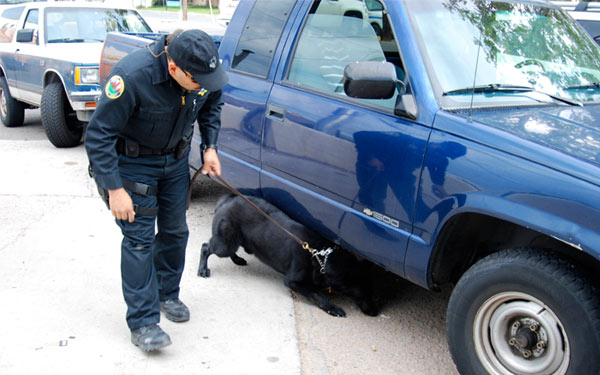
This article serves to comment on the research and evaluation activities published by Sheriff Deputy Kevin Sheldahl of Albuquerque, NM - a law enforcement officer, master trainer, and owner of K-9 Services - who undertook a carefully planned and executed evaluation of ScentLogix™ explosives training aids using a team of certified K9s and their handlers - all of which that have never been exposed to ScentLogix™ training aids prior to the study.
It has been demonstrated by handlers and trainers on numerous occasions that ScentLogix™ training aids can be used as a tool that enables a scientific approach to detector K9 evaluation and training processes, and that it provides a platform from whence different standards and theories can be formulated and tested, both quantitatively and qualitatively. This article intends to use the data presented by Kevin as a basis to (i) explain and exemplify how to our suite of training aids work, and, (ii) illustrate how to interpret data collected during its use in evaluation and training processes. It also shows how some of Kevin's astute comments from his assessments, especially that of Test #1, can be experimentally validated using mere data.
I. Experimental Considerations:
Before we embark on the analysis of Kevin's data, a scientific baseline of the variables that may affect the detection activity needs to be determined. ScentLogix™ recommends that any K9 training data should primarily contain information about 3 important variables - (i) the training aid (and its odor generation characteristics), (ii) the K9 (and its detection proficiency), and, (iii) the environment (and the way it affects both odor generation and the ability of a K9 to effectively track to source). We will quickly explore below, each of the intricacies pertaining to these identified variables.
A. The Training Aid
Whatever the circumstances might be, it is important for handlers and trainers to know a bit about the history of the training aid they use, or are about to use, during a training exercise. If they are using a parent (i.e., real) training material, questions such as (a) how pure is it? (b) what is the surface area (not the weight)? and, (c) how old is it? are important areas-of interest that should be asked of a training aid before use, since this can help establish if such an aid is appropriate for either imprinting or field training, or both, and help identify the true utility limits of the aid (if it can be used for water detection, vapor-trailing, or determining how much surface area of material it represents). ScentLogix™ recommends the division of scentdetection aids into two types: (i) K9-imprint aids and (ii) field-training aids. By our recommendations, an explosive or narcotic that is less than 86% pure (such as an MDMA tablet or rock-hard C4) should only be used as a field-training aid, and never as an imprint aid. Also, an explosive or narcotic that is over 6 years old should not be used as an imprint aid but is still suitable for use as a field-training aid (except in situations such as some mine detection scenarios).
There are other important aspects, pertinent to the profession, which trainers and handlers seem to unintentionally disregard when considering and selecting a scent-training aid. One aspect pertains to a total disregard for odor preservation and a preference for material preservation, after their acquisition of training aids. It needs to be universally understood that an explosive ceases to be an explosive once it becomes a scent-training aid, and a narcotic ceases to be a narcotic once it becomes a scent-training aid. Their acquisition purpose is for scent detection, their true value is in their odor, and the preservation of this odor should be an all-important process. Of what use is a narcotic that has spent over 1,000 hours in the trunk of a squad car in Florida or Mexico City, or Indonesia, in July, or of an explosive stash that has spent the same amount of time in a bunker in Arizona, or Sydney, or Kong Kong? Would you still call these imprint aids? A training aid obtained from the DEA is at least 10 years old due to the statue of limitations and the level of purity is mostly unknown…is this still a good imprint aid for the discipline of scent detection? Is hard-and-crumbly C4 a good imprint aid? And if any of these aids is used, should we expect any limitations in the efficiency of a K9 in finding real materials in theatre? This should be serious food for thought to any handler or trainer when selecting a training aid.
Another aspect typically downplayed is the understanding of what a scent training aid is and the scope of function it is supposed to have (it's specifications) for it to optimize the training efficacy of a K9. The simple utility of a scent-training aid is to train K9s to seek-and-detect an object through the exclusive use of their sense of smell, with minimal, if any, contribution from their sense of sight. So how many trainers take “the visible” out of their training programs by training in rooms with no light or in pitch dark environments, using only night vision goggles in their search? Let's rephrase this; how many stop training simply because it is “too dark”? And as far as likeness is concerned, does a cocaine training aid have to look like cocaine or does a TNT scent-aid have to look like TNT before it can be considered a good training aid? No! A detector K9 never knows what a material truly looks like. For example, you imprint a K9 on Semtex/cocaine by putting the Semtex/cocaine scent-training aid in a Scent Box or a wall arrangement (the K9 never sees the aid), then you start to search for the aid (the K9 doesn't see it), the K9 alerts (doesn't see it), is rewarded (does not see it) taken away from the hide location (does not see it), and the hide is removed (does not see it). In fact 99% of detector K9s never know what material they are looking for by its physical appearance (using the sense of eyesight), in their lifetime. They find materials through the sole act of scent detection, using the materials odor. This is nose-sight, not eye-sight. Moreover, when it finds the material, it does not identify it (alert) through visual identification of its physical properties, but through the identification of its odor. Thus, within the paradigm of realistic scent detection, the training aid material is therefore not the true training aid. The true aid is the materials odor.
With this established, it is only sensible to define an ideal training aid as that aid in which the selection emphasis is placed NOT on the physical (it explodes!) or physiological (it is a drug!) characteristics of the material itself, but in it having the prerequisite subset of odors (i.e., scent signature) necessary to effectively train a K9 in detecting all weights of the material-ofinterest, wherever hidden, in all environmental conditions (we live on a hot planet that will always sustain the presence of a scent signature), and in all concealment scenarios.
ScentLogix™ training aids are a representation of the odor of the material rather than the material itself. It's about “real” odor, and not “real” material. In fact, each training aid is an "odoriferous" equivalent of the parent material, which is manufactured and packed using processes that ensure that no cross contamination of the training aids can occur during use. It is a material that generates pure odor, and the odor generated by each ScentLogix™ training aid represents the odor of up to 500 pounds of the explosive or narcotic material it represents. Our aids are so “parent odor” that you do not need to fool your K9 that you are using real, by using a blank or distracter odor to proof your K-9 off after training. Yes, you do not need any distracter odors when you train with ScentLogix™ scent-training aids. Doesn't this tell you something about what is “real” or not, when your dog is telling you that it needs a distractor (or “blank”) with your training aid to fully understand the odor of the material it is supposed to detect? When has it become okay to train a dog to detect a hamburger buy imprinting on a cheeseburger and then proving it off the cheese.
Scent engineered for superior odor availability and generation, no cooking time is needed for ScentLogix™ training aids before starting your search. Just hide your aids, go get your K9, and start your training run! And you can then imagine the scenario when such an explosive aid is placed in a static air environment such as a classroom, and allowed to cook - its odor will fill up the classroom so quickly that the classroom itself will quickly become "the bomb" i.e, the object to detect, and you will find K-9's alerting at the door seams of the classroom, even before entering for a more detailed search to pinpoint the location of the hide. By letting the aid sit for extended periods, the ScentLogix training aids can be used to simulate large amounts of explosives/narcotics for use within a detector K9 training program. So, in order to generate a scenario where large amounts of, for example, an explosive, is to be simulated, just place the prerequisite ScentLogix training aid in a small room (e.g., 10 x 10) with no open windows and let the aids cook for about 30 minutes (at summer temperature, allow more time for winter). Such a scenario can be used evaluate a K9's proficiency in detecting large quantities of explosives, whereby only K9's well trained in detecting large amounts of explosives will be able to perform well (a limitation brought about by the use of real training aids). As an imprint aid, it can also be used to train K9s in detecting large amounts. And if lower amounts of odor output are needed, the training aid can be made to produce different (variable) amounts of odor by simply leaving the aid within its pack and venting the pack to varying degrees, from having the pack very-slightly open to completely open. Another method is to completely take the aid out of the pack, wrapping the aid within a clean odor-free face towel or two, stashing this as a hide, and immediately bringing your K9 out to start searching seconds after it is hidden.
B. Measuring Quality: The K9 Response
Before embarking on a study of scientific merit, K9 response expectations should also be well anticipated and defined by an K9 scent-performance evaluator. ScentLogix™ recommends quantifying a K9s 1st pass on any training aid by using a scale of 1 to 10 in the categories (i) alert (ii) interest, but no alert, and (iii) no interest. By our standards at ScentLogix™, a proficient search-and-detect training aid should be good enough to train a K9 to detect a material by its odor at its first pass (i.e., the first time the K9 encounters the material), so we consider the delectability of a material by a K9 at 1st pass as a most-important criteria for assessing the efficacy of the K9 in a search-and-detect exercise. The 2nd pass information is used to confirm the 1st pass information, however this 2nd pass information might not be very accurate due to a variety of factors pertaining to either the K9 (e.g., the K9 being tired by the time the 2nd pass is performed since he is 1 of 25 dogs being assessed), the material (e.g., saturation of search area by target material's odor to the extent that is representative of a large target for which a K9 has not been trained to find, or the aid had been removed!). It is therefore important to properly quantify a 1st pass alert and not just qualify it. Another K9- based presumption we make is founded on simple logic - when a K9 that does not alert on any of the passes (0,0,0) when other K9s are alerting, it can be assumed that the K9 does not know the odor, and such an assumption is upheld until the K9 passes similar tests to prove otherwise.
C. The Test Site: Environmental Considerations
It is always important to note the prevailing air temperature and movements of any test/training site prior to, and during an exercise as these factors can turn what might seem to be the same undisturbed training site, into a different test environment each test session, given that every 8OC increase in temperature causes significant (and unseen) changes to odor dynamics and affects probability for detection within the search area. The availability and use of air supply ducts within a test site can greatly modify the air dynamics of a test environment. Heat is energy that acts as a super highway for odor and I am sure everyone has seen the shimmering surface of a hot road, as heat radiates (travels) from it, ready to carry odor within its energy current which is now so strong that it is now a visible radiating shimmer. So heat itself causes air currents, which, in combination with general air movements (note the acknowledgement of both temperature induced micro “air currents” and mass “air movements”), controls odor dispersivity once it is released into the environment by the material. Air itself can either be static (stagnant, not moving, so odor moves by diffusing within the air mass) such as in enclosed spaces or dynamic (moving, so the air mass itself is moving as odor is diffusing through it) such as in airy places and the outdoors. Alas, training problems of varying complexity can be set up by exploiting these properties using. The most commonly cited definition used to explain the movement of odor, vapor pressure, this rarely a valid definition to use when explaining odor movement. But this is another story. With this in mind, let's take a look at Kevin's test results. From Kevins data, 11 Police Service Dogs (PSDs) were used overall and these were from two different groups (PSDs 1- 6 and PSDs A - E), each having two passes per explosive hide. For complete clarity of comments, the actual results obtained by Kevin are displayed as tables before each comment. For Kevin's experiment and his full justification for the experimental setup, please see his article at www.leerburg.com/scentlogix.htm.
II. Test Results and Data Interpretation
A. Test 1, Classrooms:
| Police Service Dog | TNT | RDX | Smokeless | Semtex | Dynamite |
|---|---|---|---|---|---|
| #1 | 1,1 | 1,1 | 0,0 | 1,0 | 1,1 |
| #2 | 1,0 | 1,1 | 1,0 | 1,0 | 1,1 |
| #3 | 1,1 | 1,1 | 1,1 | 1,1 | 1,0 |
| #4 | 1,0 | 1,1 | 1,0 | 1,0 | 1,1 |
| #5 | 1,0 | 1,1 | 0,0 | 1,0 | 0,0 |
| #6 | 1,1 | 1,1 | 1,0 | 1,1 | 1,1 |
Considerations: Since Test #1 was carried out in a small enclosed space, we know that odor generated by the training aid will be controlled by static (non-moving) air current conditions…the more the aids cook, the more the scent will fill the room and the more difficult it will be to find the aids. We can also anticipate that there may be errors made by the K9's during the 2nd pass as the enclosed space where the placement is hidden might have become overtly saturated by the odor by the time the K9 makes its 2nd run. And, if this is the case, we realise that the longer a K9 waits to make a 2nd run the greater the possibility that he might miss the hide since it is now representing a large hide.
Test Results: Test #1 shows that there was a 100% DETECTION RATE BY ALL K9'S AT FIRST PASS! This is true since the assumption has already been established that K9s that did not alert at all on any of the passes (0,0) do not know the odor of large explosives (and there was no (0,1) either), their data can be excluded/ignored from the test as they were not trained in that particular art! So, from the K9's that know the odor of large amounts of the explosives, the following conclusions can be made from the data:
- 100% detection of TNT by all K9s at first pass.
- 100% detection of Semtex by all K9s at first pass.
- 100% detection of SP by all K9s at first pass.
- 100% detection of Dynamite by all K9s at first pass.
- 100% overall detection of RDX by all K9's - All K9's are good at detecting large amounts of RDX.
And the following PSD-specific comments can be made:
- PSD #5 is the least proficient K9 in the group when it comes to detecting large amounts of explosives.
- PSD #5 cannot detect large amounts of SP or Dynamite explosives.
- PSD #1 cannot detect large amounts of SP.
- PSDs #6 and #3 are very good K9's in detecting large amounts of explosives: This is because they only had one miss each during the second pass (#3 might have a slight edge because it alerted to smokeless powder during the 2nd run).
Kevin's mention of the strong smell of Semtex is evident in the data: all K9's alerted to Semtex during 1st pass but fewer K9's could detect it during 2nd pass. This is because the amount of odor generated by the time of the 2nd pass (in a static environment) would have made it represent so large an explosive that only the best of the K9's will be able to detect it. So, it can be stated that PSDs #3 and #6 are very good detectors of large amounts of Semtex.
B. Test 2, Vehicles:
| Police Service Dog | TNT | RDX | Smokeless | Semtex | Dynamite |
|---|---|---|---|---|---|
| #1 | 1,1 | 1,1 | 1,0 | 1,1 | 1,1 |
| #2 | 1,1 | 1,1 | 1,1 | 1,1 | 1,1 |
| #3 | 1,1 | 1,1 | 1,1 | 1,1 | 1,0 |
| #4 | 1,1 | 1,1 | 1,0 | 1,1 | 1,1 |
| #5 | 1,1 | 1,1 | 1,1 | 1,1 | 1,1 |
Considerations: This test scenario is very different from the first. This test was run outdoors where there is a dynamic air environment. In this case the air moves and as the odor is released into the environment it become well dispersed to increase the length and breadth of detection. A K9's nose is seen at its best in a dynamic air-movement (i.e., open-air) environment, and, when a good training aid is employed, K9's can be seen to home in on the material from as far as 500 yards.
Test Results: The following opinions can be generated from the data:
- 100% detection of all explosives by all K9's at first pass.
- 100% overall detection of TNT, RDX and Semtex by all K9's.
- 100% overall detection of all explosives by PSDs #2 and #5.
- 100% overall detection rate for #5; so contrary to information obtained in test #1, PSD #5 is trained on SP and Dynamite!
And the following PSD-specific assumptions can be made:
- Kevin's assumptions about PSD #5 in test #1 are correct since it aced the test this time around!
- PSD #1 cannot detect large amounts of SP
- From the performances shown in Tests 1&2, PSDs #5 and #2 are better at being dynamic-air detection K9s than static air detector K9s.
And there is a question:
- I wonder why PSD #3 did not detect dynamite during 2nd pass in Test 2, just like in Test #1?
C. Test 3, Large Rooms:
| Police Service Dog | TNT | RDX | Smokeless | Semtex | Dynamite |
|---|---|---|---|---|---|
| A | 1,1 | 1,1 | 1,1 | 1,1 | 1,1 |
| B | 0,0 | 1,1 | 1,1 | 1,0 | 1,1 |
| C | 1,1 | 1,1 | 1,1 | 1,1 | 1,1 |
| D | 1,1 | 1,1 | 1,1 | 1,1 | 1,0 |
| E | 1,1 | 1,1 | 1,1 | 1,1 | 1,1 |
Considerations: Here, Kevin mentioned that the class room was larger, so, although restricted by walls, there will be better air circulation within the classroom. However, depending on the sit time allowed for the aids to cook, this may still be considered static odor. During this test PSD #B missed TNT twice, so it can be assumed that he has not been trained to detect large amounts of TNT and taken out of the equation since this means that he is taking a test he was not trained for.
Test Results: With this assumption made, the data reveals itself as follows:
- 100% detection of all explosives at first pass by all K9's.
- 100% overall detection rate of all explosives by PSDs #A, #C and #E, and only 1 miss by #D.
And the following question is asked:
- PSD #B does not know TNT odor. If it does, then why did he miss it 100% of the time?
D. Test 4, Vehicles
| Police Service Dog | RDX | Semtex | Dynamite |
|---|---|---|---|
| A | 1,1 | 1,1 | 1,1 |
| B | 1,1 | 1,1 | 1,1 |
| C | 1,1 | 1,1 | 1,1 |
| D | 1,1 | 1,1 | 1,0 |
| E | absent | absent | absent |
Considerations: Here, we go back to a dynamic airflow system again where conditions and considerations are similar to test #2.
Test Results: The following observations were made from the data:
- 100% detection of all explosives at first pass by all PSD's.
- 100% overall detection of all explosives by PSDs #A, #B and #C.
- Only 1 miss during test. If not for 1 miss by PSD #D there would have been 100% overall detection of all explosives by all PSD's.
And the following questions were raised:
- Why, like in Test #3, did PSD #D miss Dynamite twice at 2nd pass? Maybe it does not know the odor of large amounts of Dynamite.
E. Test 5, Luggage:
| Police Service Dog | Smokeless | TNT |
|---|---|---|
| A | 0,0 | 1,0 |
| B | 1,1 | 1,1 |
| C | 1,1 | 1,1 |
| D | 1,1 | 1,1 |
| E | 1,1 | 1,1 |
Considerations: Here, we have a quasi-dynamic air flow system. Since the training aid is contained within luggage that is slightly vented, the air in the bag is static. Before odor is released into the environment, the luggage is first filled, and then released into a dynamic environment in controlled way (through the vent in the bag rather than through the whole surface area. So the luggage vent controls the rate of release of the odor to the environment and the quantity, and this quantity is less than what can be released by the training aid itself.
Test Results: The following conclusions can be made from the data:
- 100% detection of TNT by all K9's at first pass
- PSD#B had a 100% overall detection of TNT compared to Test #3 where it had a 0% detection of the same material
- PSD#B can detect TNT in a dynamic-air environment (small amounts of material) and not in a static environment (large amounts of material). Since the TNT was in a bag this time, the odor was released slowly.
- Since PSD#A had performed well on previous occasions with SP and TNT (it had 0 misses in tests 3 and 4!), this substantiates the fact that PSD#A was having a "bad" day! Alternatively, it can be argued that PSD#A does cannot detect small amounts of explosives (which is still impossible if the K-9 was trained only on large amounts).
- If not for the “bad day” had by PSD#A, there would have been a 100% detection rate of all explosives by all K9s.
F. Further Observations:
All the K9's detected the ScentLogix™ Smokeless Powder at one time or the other during the course of the tests, no matter what SP brand they had originally been imprinted/trained with! There always have been problems with K9s trained on one brand of SP alerting on another brand. Such problems have been investigated and published by academic colleagues such as Dr. J.M. Johnston at Auburn. None of such problems was encountered during Kevin's test of ScentLogix™.
There were situations when large amounts of explosives were completely missed (0,0 in a static environment) but this never happened within a dynamic environment. So, all the K9's within this test study need more training using large amounts of explosives.
III. Conclusion and Acknowledgement:
We hope this document clearly illustrates how ScentLogix™ ScentKits (and the right scientific considerations, of course) can be used as tools of scientific enquiry by handlers, trainers, evaluators and other professionals within the detector K9 community. And with such enquiry, K9s can be quantitatively rated into categories of operational importance more precisely. Our solid understanding of materials science and olfaction has enhanced our understanding that there are training-aid induced factors such as target odors, scent generalization, false positive responses, and contamination, which do affect detection accuracy… in ways which we feel are imperative to share with the community at large.
Overall, we deem that the tests performed by Deputy Kevin Sheldahl further establishes the fact that ScentLogix™ can be used as an effective operational training aid for, at least, maintenance training of explosives detection K9s. Other reputable trainers, such as Nate Harves, have published results on studies that also involved K-9's imprinted on ScentLogix™. (See http://sportwaffenk9.com/policek9.narcpseudo.shtml for more information on this study). And, regarding the question of if these aids “can serve as maintenance aids that are as effective as using real aids” …well, are the data results presented in this study as good as what can be expected from these K9s if real explosives were used as the target material? Yes, we do think so, especially since 100% of the K9s trained on real aids alerted on the ScentLogix™ explosive aids at first pass, and on first exposure, just was we would expect them to alert on real materials. Some K9s trained on real would not even alert on real explosives when being exposed to them, for the first time, in an unrehearsed training scenario. Yes, these are good, well-trained dogs. ScentLogix™ says so!
We thank Kevin Sheldahl for a wonderfully presented preliminary evaluation. His experience in the field of detection is apparent in his inquiry and data presentation - all performed on his own personal time and expense. We also thank Ed Frawley, owner of the wonderful Leerburg website, for publishing Kevin's evaluation. None of these guys were asked to do this evaluation, nor was any of them paid for this valuation. It'll be nice if others too can publish their experiences with any of non-parent-material training aids currently available on the market, for the community to learn from, and share experiences.



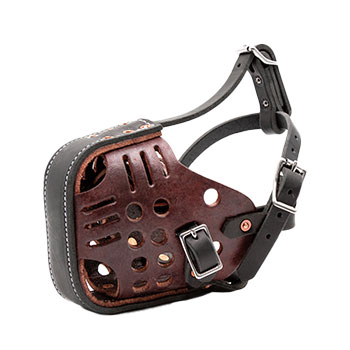
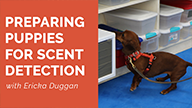
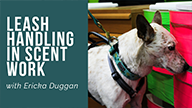
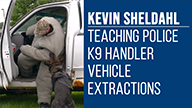
Ask Cindy.